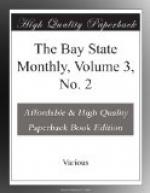BOOK REVIEWS.
ORIENTAL RELIGIONS AND THEIR RELATION TO UNIVERSAL RELIGION. By SAMUEL JOHNSON, with an introduction by O.B. FROTHINGHAM. Persia, Boston: Houghton, Mifflin & Co., 1885.
This is the third volume of the series, and was not quite completed at the time of Mr. Johnson’s death in 1882. The other volumes, on India and China, created much interest in the world of religious and ethnical study, a prominent London publisher and literateur saying to a friend of the present writer that nothing more would need to be written of China for the next quarter of a century. Max Muller testified to the high value of Mr. Johnson’s work.
In the study of the various religions, the author finds in each some peculiar manifestation of the universal religious sentiment. In Southern Asia he clearly sees nature almost absorbing the individual and hence a pantheistic vagueness and vastness in which man does not realize a complete sense of personality. But in the North and West the same Tudo-European race comes to a self-conscious individuality and there is the “evolution and worship of personal will.” Mr. Johnson’s first chapter on “Symbolism” brings out this epoch of will development as illustrated by the Persians,—the human soul impressing itself upon the material world—and finding outside itself natural emblems to express its religious life. “Symbolism is mediation between inward and outward, person and performance, man and his environment.” “Work is the image man makes of himself on the world in and through nature.” Mr. Johnson finds the personal element becoming supreme in these people of Northern and Western Asia.
Perhaps there has never been so philosophical and satisfactory a treatment of the Fire-Symbol, which, however, our author says is not peculiar to the religion of Persian Zoroaster, as we find in Mr. Johnson’s chapter under that head. As light, heat, cosmic vital energy, astronomical centre, as all producing and all sustaining force, the sun and the other burning and brilliant objects lighted therefrom, furnish very much of the symbolism of all religions. “The Sun of Rightousness” is a favorite figure with Jew and Christian. It is doubtless as incorrect to characterize the Persians as “fire worshipers” as it would be to say that Christians, who use the same symbol, give their worship to the symbol rather than the Being symbolized. Still our author finds this emblem a very important one in the religion of the followers of Zoroaster and thinks he detects a progress in thought and civilization marked by the coming of the people to give religious regard to the sun and heavenly bodies, instead of fire kindled by human hands—a new stability of being corresponding with the passage of early people’s art of nomadic or shepherd life into agriculture with its fixed abodes and domestic associations.




